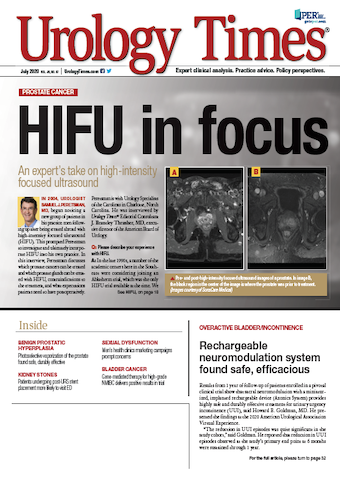Publication
Article
Urology Times Journal
It’s time to prepare for upcoming E/M coding changes
Author(s):
The deletion of code 99201 is among the evaluation/management coding changes for 2021.
The year 2020 has been challenging for everyone. The Centers for Medicare & Medicaid
Jonathan Rubenstein, MD

Services (CMS) has made several unprecedented changes to adapt to the coronavirus disease 2019 (COVID-19) public health emergency (PHE), with other payors following suit.
Mark Painter

However, as stay-at-home orders are lifted, we are seeing several payors roll back or partially roll back some of the implementations regarding the use of telehealth. The health care system changes are only a fraction of the challenges each urology office is facing. We have been impressed with the innovation and outside-the-box thinking that many have taken on and shared with others to meet the challenges facing us. We encourage you to keep thinking and trying new things.
For this article, we are going to focus on a “burning” question that we have been asked repeatedly: With all that is happening, is CMS going to move forward with the adoption of new guidelines for E/M office coding?
Briefly, we can answer with a qualified “Yes.”
We are writing this article just prior to the release of the proposed rules for the Physician Fee Schedule. For a refresher on Medicare rule making, CMS releases a proposed rule for physician payment each year toward the end of the second quarter (late June or early July). This rule allows CMS to receive and react to suggested changes in the way physicians will be paid during the following year. Societies and individuals can provide direct feedback to CMS with arguments for or against these changes. Medicare reviews this feedback and incorporates its response in the final rule, which is typically released in October or early November. The final rule sets the policy for the forthcoming year. CMS is also required to accept and review comments on this rule, but it is unusual for the agency to make major changes at this stage.
Recall that the final rule for 2020, released in November 2019, included a commitment to adopt the upcoming changes in evaluation and management (E/M) codes, revise the relative value units (RVUs) for office and other outpatient E/M codes, and add or adopt codes to address additional time and impacts on certain specialties.
CMS also partially adopted the proposed documentation changes for 2021 E/M codes to allow for services provided via telehealth during the PHE. In short, our qualified “yes” regarding whether or not CMS will adopt the E/M changes for 2021 is based on what CMS has published. In addition, the American Medical Association (AMA) has indicated they will proceed with an updated publication of the office and other outpatient Evaluation and Management Services Guide, required for use under HIPAA. Our answer is qualified because CMS has not yet issued the final rule and, as we have seen, the agency could make alterations at the last minute.
We will focus on a few highlights of the upcoming changes and the preparations we recommend for the remainder of this year.
First, code 99201 will be deleted.
Second, and more importantly, history (H) and physical (P) examination will no longer follow the requirements currently included in the guidelines for 1995 or 1997. Instead, the new guidelines require only that the documentation include a medically necessary and appropriate H and P.
Hopefully, all of you have been using this new approach to H and P for your telehealth visits provided for Medicare and your Medicare advantage plans during the PHE. CMS adopted this change to the documentation guidelines for telehealth in its March 30 rule. Adapting to the change allows you to charge more appropriately regarding the medical decision making required for remote office visits. It should also give you a partial road map to the changes you may need to make to your EMR templates and patient intake forms, which can be fully implemented on January 1, 2021.
We encourage you to contact your electronic medical record (EMR) vendor to find out whether they are planning to update the current E/M calculator. Regardless of whether your vendor is able to keep up with the changes, we encourage you to learn the new rules in preparation for the changes so you can report the correct code for the services you provide now and in the future.
Definition of time amended
The other change adopted for the PHE was the amended definition of time. Although the 2021 updates in current procedural terminology will take things a step further by including revised time ranges for each E/M new and established office visit, the concept has already been implemented during the PHE for telehealth visits. Currently, time can be used as the overriding factor if you spend over 50% of the E/M face-to-face visit time in counseling and/or coordination of care, and document it. Under the new definition (again, currently allowed for telehealth visits), you can use time to select the appropriate level of service reported regardless of how much time you spent in counseling and/or coordination of care. In addition, the new definition of time allows you to count the total time spent during the date of service in support of the E/M encounter. For documentation, you will need to record total time. This includes time spent directly with the patient, reviewing records, discussing with other providers, coordinating care, and so on.
We do not yet know the extent of detail you may need to document. As is the case today, you are not required to document time unless it is to be used to determine the level of service charged. Further, although time is appropriate for some encounters, most urology encounters would be more accurately and efficiently reported by reviewing the medical decision making required.
The new guidelines rely primarily on the medical decision making documented. These proposed changes were not adopted for the PHE but will be adopted on January 1, 2021, for all new (99202-99205) and established (99211-99215) office visit codes. The new guidelines for medical decision making will require some education as the changes published by the AMA have been revised. The changes to this portion of the E/M office new and established patient guidelines include the same main categories of Number of Problems, Amount of Data, and Amount of Risk. What has changed is the way in which these categories will be divided by level.
Number of Problems is now based on severity of problem, with little accommodation for the number of problems addressed. Amount of Data is grouped by category, and the number of categories and amount of data for each category are used to determine the appropriate level of service. Amount of Risk is similar to the existing risk table, but has been simplified by grouping the former three columns of risk into one table representing the risk of morbidity from additional diagnostic testing or treatment.
We urge you to take time this fall to educate yourself on these changes. The American Urological Association and Physician Reimbursement Services will be offering courses on the new system over the remaining months of 2020, as well as providing support in 2021. Further, follow up with your EMR vendor to ascertain what changes if any are being made to your system to accommodate these updates. Although change is always difficult, we feel that these changes will be of great benefit to urologists once they are implemented. Get ready and embrace this challenge.
The information in this column is designed to be authoritative, and every effort has been made to ensure its accuracy at the time it was written. However, readers are encouraged to check with their individual carrier or private payers for updates and to confirm that this information conforms to their specific rules.































